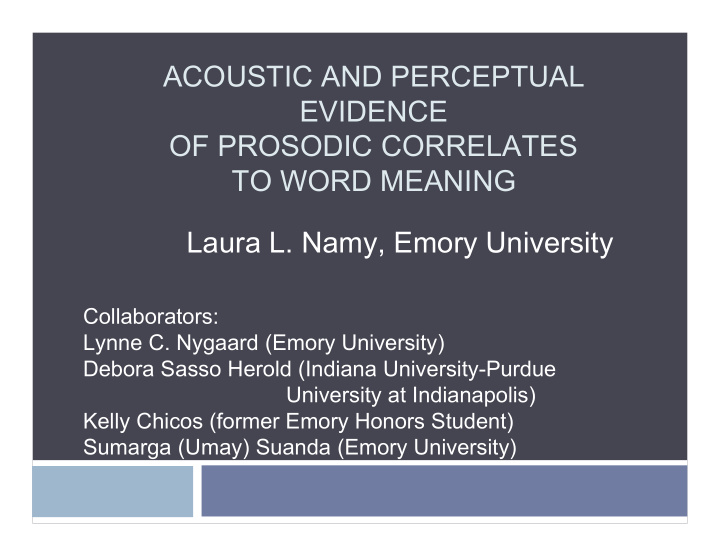



ACOUSTIC AND PERCEPTUAL EVIDENCE OF PROSODIC CORRELATES TO WORD MEANING Laura L. Namy, Emory University Collaborators: Lynne C. Nygaard (Emory University) Debora Sasso Herold (Indiana University-Purdue University at Indianapolis) Kelly Chicos (former Emory Honors Student) Sumarga (Umay) Suanda (Emory University)
Prosody Intonation, Stress, Loudness, and Timing Provides information about Linguistic Structure Emotional State of Speaker Indexical overlay Not integrated with meaning
Evidence for integration Emotional TOV and lexical processing (e.g., Nygaard & Lunders, 2002) Facilitation of semantic processing outside of emotion (e.g., Shintel, Okrent, &Nusbaum,, 2006)
Kunihira (1971) Japanese antonym pairs (e.g., strong/weak, walk/run) Native English speaking participants 3 conditions Orthographic Neutral Expressive Assign meanings to each word in pair
Prosodic correlates to word meaning? Acoustic properties that differentiate meanings Unique correlates for individual meanings beyond valence Functional significance for novel word interpretation? Adults Children Mechanism
Acoustic Analysis Are there prosodic features that differentiate meanings within antonym pairs? Are these features consistent across speakers? Are there unique acoustic profiles that characterize each dimension of meaning?
Stimuli 12 dimensional adjectives (6 antonym pairs) Happy/sad, hot/cold, big/small, yummy/yucky, tall/short, strong/weak 6 bi-syllabic nonsense words Riffel, blicket, seebow, tillen, foppick, daxen 3 female speakers using novel words in IDS “Can you get the daxen one?” Neutral and meaningful prosody
Valence ratings Each of the 12 meanings (and 8 fillers) Positive and negative ratings Likert scale: 1(not at all positive/negative) to 7 (extremely positive/negative)
Acoustic measures Four measures differentiated meanings: Fundamental Frequency (F o ) F o variation Amplitude Duration Analyzed both full sentence and novel word
Related to Valence? Positive Rating Negative Rating F o .54^ -.51^ F o variation .70* -.71* Amplitude .71* -.62* Duration -- -- Nygaard, Herold, & Namy, 2009
Unique acoustic profiles differentiate meanings F o F o Amplitude Duration variation Happy/sad Hot/cold --- --- Big/small --- Tall/short --- Yummy/yuck --- --- --- y Strong/weak --- --- Nygaard, Herold, Namy, 2009 ---
Unique acoustic profiles differentiate meanings F o F o Amplitude Duration variation Happy/sad Hot/cold --- --- Big/small --- Tall/short --- Yummy/yuck --- --- --- y Strong/weak --- --- Nygaard, Herold, Namy, 2009 ---
Unique acoustic profiles differentiate meanings F o F o Amplitude Duration variation Happy/sad Hot/cold --- --- Big/small --- Tall/short --- Yummy/yuck --- --- --- y Strong/weak --- --- Nygaard, Herold, Namy, 2009 ---
Unique acoustic profiles differentiate meanings F o F o Amplitude Duration variation Happy/sad Hot/cold --- --- Big/small --- Tall/short --- Yummy/yuck --- --- --- y Strong/weak --- --- Nygaard, Herold, Namy, 2009 ---
Acoustic analysis -Conclusions Prosodic cues that differentiate meanings on both valence and semantic basis Consistent across speakers Similar prosodic features for related domains of meaning
Do parents spontaneously employ prosodic cues to word meaning? 14 mothers and their 2-year-old children Read picture book –encouraged to interact ‘naturally’ Read target sentence (e.g., “Look at the tall one!”) Blind to purpose of study
Mothers’ spontaneous use of prosodic cues to word meaning
Mothers’ use of prosody to differentiate meaning F o F o Amplitude Duration variation Happy/sad --- --- Hot/cold --- --- Big/small --- --- Tall/short --- --- Yummy/yuck --- --- y Strong/weak --- --- Herold, Nygaard, & Namy, 2010
Mothers’ use of prosody to differentiate meaning F o F o Amplitude Duration variation Happy/sad --- --- Hot/cold --- --- --- Big/small --- --- --- Tall/short --- --- Yummy/yuck --- --- --- y Strong/weak --- --- Herold, Nygaard, & Namy, 2010
Mothers’ use of prosody -Conclusions Preliminary evidence is suggestive Parents spontaneously employ prosodic cues to meaning Even in constrained task Spontaneous utterances in naturalistic contexts required
Can children and adults recruit prosodic cues in the service of novel word interpretation? To accommodate use with children, used a 2-alternative forced choice with picture pairs Listened to recorded sentences Selected picture they believed corresponded to novel word
Sample trial
Adult Study Heard all sentences neutral and meaningful all three speakers Saw two picture pairs for each sentence
Adults use prosody to infer meaning Nygaard, Herold, & Namy, 2009
Adults use prosody to infer meaning Nygaard, Herold, & Namy, 2009
Explained by Valence? If so, scrambling the pairings of sentences and pictures (e.g., play “hot” and “cold” words with big/small picture pairs) should yield similar performance Compared performance when sentences matched v. mismatched meanings
Matched pairings yield more robust effects 100 Positive Neutral Percent "positive" choices 80 Negative 60 40 20 0 Match Mismatch
Adult Study -Conclusions Adult listeners reliability differentiated meanings based on prosodic cues alone Partly due to prosodic cues to valence Clear “value added” for correct mappings Unique prosodic cues to specific domains
Can children recruit prosody to infer word meaning? 4- and 5-year-olds Single speaker Meaningful or Neutral (between subject) Learned Francine the Frog’s special names for things
Children’s use of prosody to infer word meaning Herold, Nygaard, Chicos, & Namy, 2010
Do 4-year-olds lack understanding of prosodic cues or inhibit attention to prosody? 4-year-olds children selectively attended to propositional over prosodic cues to emotion (Morton & Trehub, 2001) Relative weighting of emotional prosody over propositional content increased with development. Ability to use prosodic cues to emotion was not impaired when propositional content was masked.
4-year-old training study Meaningful prosody condition Training period –exposed to happy/sad stimuli Heard same novel word with both types of prosody Asked children to identify emotion Provided corrective feedback/reinforcement Training is non-specific
Impact of training on use of prosody Herold, Nygaard, Chicos, & Namy, 2010
Child Studies -Conclusions Both 4- and 5-year-olds can recruit prosodic information in the service of interpreting novel words 5-year-olds do so spontaneously, 4’s when encouraged to attend to prosody Earlier sensitivity?
Overall Conclusions Prosodic correlates to meaning beyond valence Spontaneously produced Consistent across speakers Both children and adults can recruit prosodic cues in the service of novel word interpretation
Current and Future Steps Prelinguistic infants? More naturalistic measures of spontaneous use Extend beyond antonyms and dimensional adjectives Disambiguating Mechanisms Iconicity Simulation Conventionalization
Recommend
More recommend